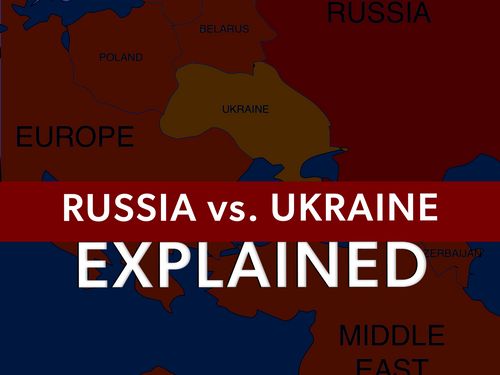Russia vs. Ukraine Explained: A Brief History
Feb 25, 2022 · 2 mins read
0
Share
The origin of the Ukranian language, culture, people and nation begins in the 800's AD with the kingdom of Kievan Rus. This federation was located in what would become modern day Belarus, Russia, and Ukraine.
Save
Share
Beginning in 1760, modern day Ukraine was part of the Russian empire. During that time there were attempts to stop the Ukrainian language from being taught and to assimilate Ukrainians into Russian culture.
Save
Share
In 1917, WW1 led to Russia's becoming a socialist state. At that point the Ukrainian People's Republic was declared. It was a tumultuous time of uprisings, but until the Nazi-Soviet invasion of Poland in 1939, Ukraine would remain divided between Poland and the U.S.S.R.
Save
Share
After WWII, Ukraine was a prosperous Soviet republic. In 1986, after the Chernobyl power plant accident in Ukraine, nationalist and pro-democracy groups formed like Rukh/People’s Movement of Ukraine. In 1991, the Ukrainian SSR declared independence from the USSR.
Save
Share
Now called Ukraine, the newly formed nation possessed a significant stockpile of the former Soviet Union's nuclear weapons. In 1994 Ukraine agreed to destroy the weapons, and to join the Treaty on the Non-Proliferation of Nuclear Weapons (NPT).
Save
Share
In 2008 Ukraine applied to join the North Atlantic Treaty Organization (NATO). Plans were shelved by Ukrainian President elected in 2010, Viktor Yanukovych. However, in 2014 Russia invaded Ukraine, making joining NATO re-prioritized.
Save
Share
In 2015 Russia, Ukraine, France & Germany signed a series of cease-fire agreements known as the Minsk Accords. However, tensions rise over numerous clashes between Ukraine and Russia including in 2016 when Russia increased military presence such as drills and movement in Crimea.
Save
Share
Tensions between Russia and Ukraine continue and escalate, leading to April of 2021 when the Russian military moved large quantities of arms and equipment into Crimea and along the border in the largest unannounced military movement since the 2014 invasion of Crimea.
Save
Share
In September 2021, Ukraine conducted military exercises with NATO forces. The Kremlin warned that NATO expanding military infrastructure in Ukraine would cross "red lines" for President Putin.
Save
Share
Though the Kremlin repeatedly denied claims that he was planning to invade Ukraine, on February 24, 2022, Russian President Vladimir Putin ordered an invasion of Ukraine by Russian Armed Forces including airstrikes and tanks entering via the Belarus border.
Save
Share
0
